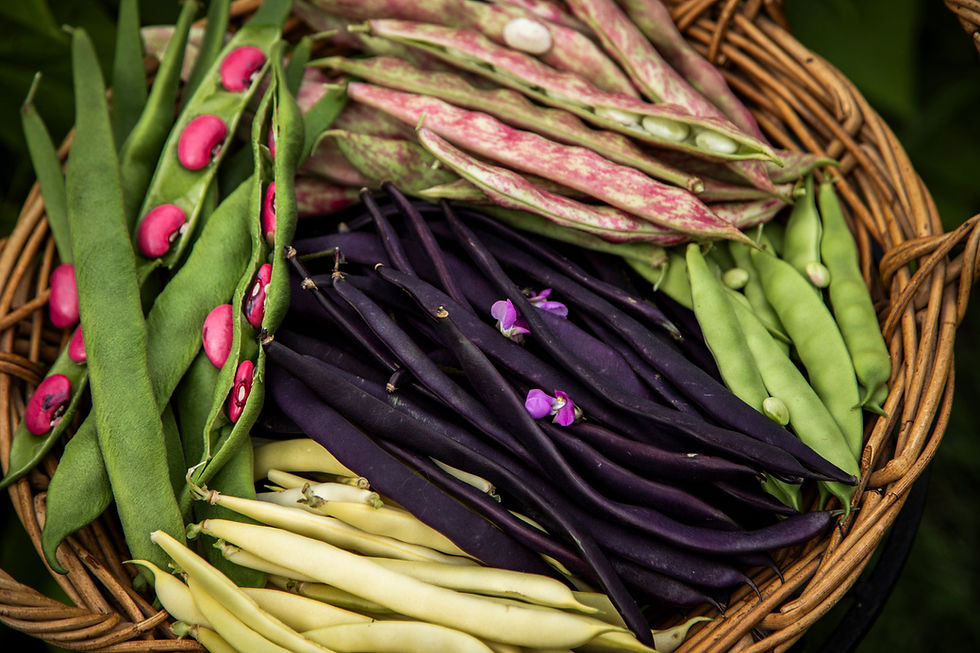Magic Beans
- Annemarie Bolduc

- Mar 6, 2022
- 4 min read
Updated: Feb 5, 2024
Discover some of the best beans that can grow successfully in a cool climate backyard garden.

Beans are very interesting! They have three harvesting stages in which they look, are cooked and are named differently. One: When the pod is young and eaten whole, they are called snap beans, green beans, string beans or French beans (but in French we say "haricots"). Two: Shelly beans are the fresh seeds of snap beans that have reached a "teen" size where the pods get tough. The seeds are larger, removed from the pod and eaten fresh or cooked without soaking. These "shellies" are great when you live in a cool climate zone with early frost as sometimes they cannot reach the mature stage. Three: If you leave the whole pod to dry, the seeds are referred to as a legume grain and called either beans or pulses (or "fèves" in French). Some varieties are best as snap beans, and some varieties, like red kidney and navy, are best as beans. There are a number of varieties around the world and the "beans" term is also used for the seeds of coffee, soy, vanilla, etc. Let's stay with legume "magic" beans for now. In recent years, one of the beans I had the most successful yield is Purple King. These stunning purple flat beans turn green after cooking, (speaking of magic!) They are delicious in all stages: raw, cooked and shelled. On top of that, the climbing plant makes a great show with its purple flowers, pods and stems!
Purple King beans at all stages • Photography © Bottle and Brush Studio 2022
I was introduced to the runner (or butter) beans when growing food. Before that, I never saw or tasted them. They are an excellent cool climate duo of a snap bean and legume plant and you can eat the pod fresh when young or save it for the nice jumbo duotone purple seeds when they reach a matured size, either fresh or cooked. The plant can be perennial if left in the ground. It never worked in my garden until one spring when I found by magic a tuber with shoots when the plant was. I kept it in a pot until the frosty weather passed, and the year after, I left it in the ground, and it still survived. Normally, I was re-sowing seeds collected from my previous harvest and even if that takes a bit more time, they are pretty hardy. The long climbing plant can also be grown for its ornamental features. I have some scarlet and pink "sunset" varieties, both of them being similar in appearance. As it is one of the most productive plants in my garden, I saved many seeds for cooking, sowing and sharing in my little collection of "Give Seeds a Chance" packets.
Runner beans for the garden and kitchen • Photography © Bottle and Brush Studio 2021
Broad (or fava) beans are an early-season variety, often grown in spring in our climate. They have been cultivated and used in cuisine around the world forever but were not known to me before moving down under. I was curious to try these giant green beans so I've been busy sowing them. They grow pretty well here and I like their taste. The only problem I have is preparing them...! I find it is so much work to shell the seeds from those thick pods, plus removing the skin, for not much food left to eat... It is good that the whole plant brings a good nitrogen fix in the compost. I haven't developed any recipes with this legume yet, but they can be used like peas and beans in many dishes like soups, stews, and salads. They are one of the main ingredients in the famous Middle Eastern falafel.
Broad beans to begin the growing season • Photography © Bottle and Brush Studio 2021
GROWING & COOKING TIPS
Growing beans is fun as you can explore and taste varieties not sold commercially. Depending on the climate you live in and other factors like weather conditions, soil, and time of sunlight may affect how your beans grow. Since I started to grow veggies in my garden, I tried many different varieties. In a small backyard, climbing types are an excellent space-saving choice. In cool climate regions, the summer growing season is short, and beans are hyper-sensitive to frost. My veggie patches are not large enough to grow the "three sisters" trio of beans, corn and squash. Native Americans taught this companion planting method: the beans feed the soil (nitrogen), the corn supports the beans and the squash makes a ground cover to keep the soil moist. My "two sisters" front yard patch, which we dug up for more growing space, is prolific. The Purple King beans, supported by the sweet corn, looked fabulous and so happy together! The Australian "butter" yellow beans and the "frost" pea beans are also great climbers for cool climate zones.
Two sisters on my front lawn • Photography © Bottle and Brush Studio 2022
How I use any snap beans is often boiled on the side, in a stir fry, in soup or added into my garden shepherd's pie Harvest Parmentier. Munching them freshly picked is also great! They are a great source of vitamins and protein. Snap bean pods can be stored in the fridge for a few days, blanched and frozen, pickled or dehydrated. Dried beans can be stored in a jar in a cool, dark place for months. They must be soaked overnight and boiled in water before being added to a dish to remove the toxins. In Québec, white navy beans are used in traditional "Fèves au lards" baked beans (see Maple & Bacon Baked Beans). Runner-shelled beans are nutritious and perfect in winter dishes like this Magic Chilli.
Colourful and magic beans • Photography © Bottle and Brush Studio 2019-22
Check out related posts, recipes and inspirations:




















































